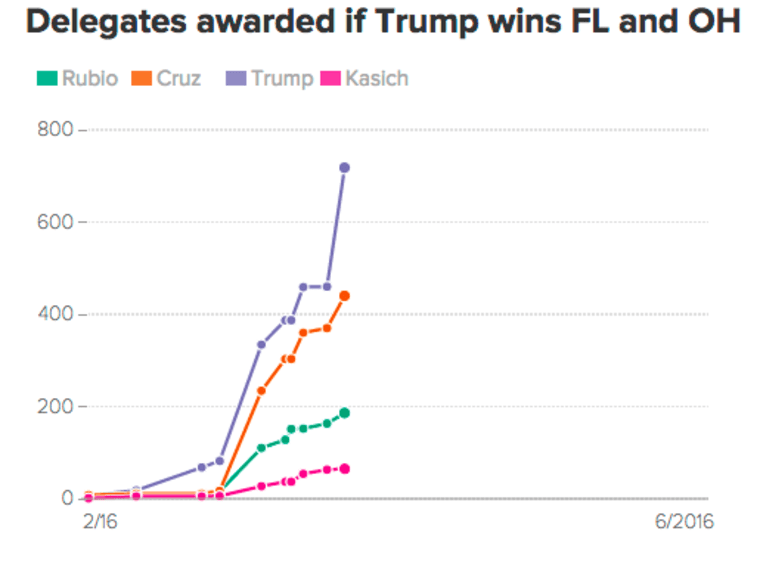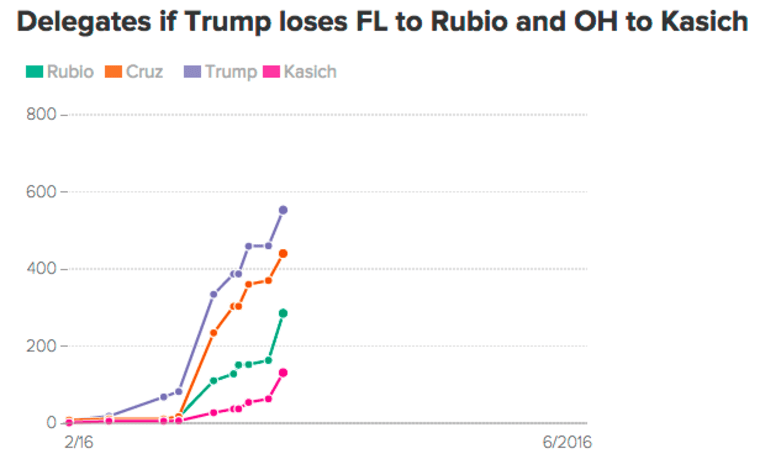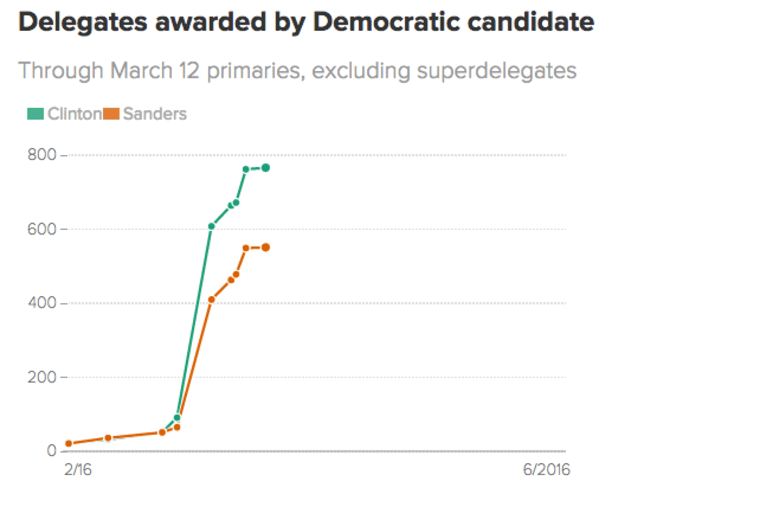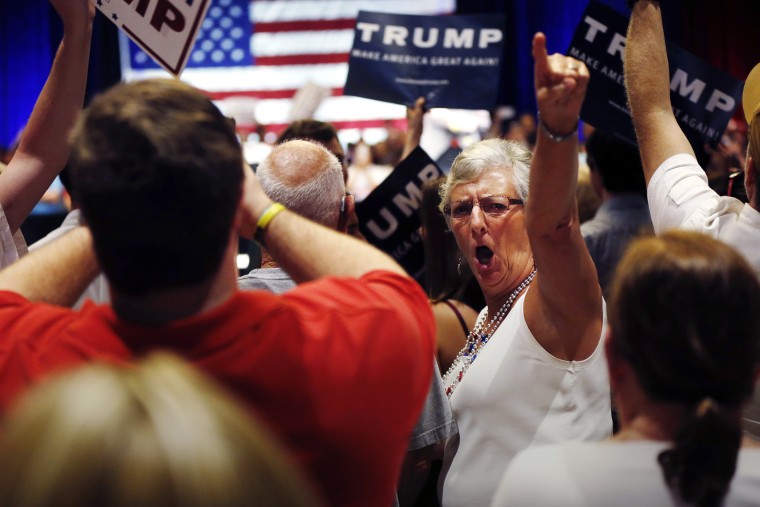The 2016 presidential race enters another critical night Tuesday, with a pile of delegates at stake that many believe will determine the eventual nominee of the Republican and Democratic contests.
Though, truth told, this election has been anything but predictable. Already, more than 1.1 million early votes have been cast in the Florida Republican primary, more than three times the number of total votes cast in the Iowa and Nevada primaries combined.
But it is possible to get a sense of where Tuesday's results may turn. Here are six key data points to help get your bearings straight ahead of Tuesday's primaries.
1. Unless Trump loses Ohio and Florida, he will start to pull away
Despite the amount of attention Donald Trump continues to command, the delegate count in the GOP race is still close. The top candidates still have a ways to go before reaching the 1,237 needed for the nomination.

That will not be true anymore after Tuesday if Trump wins Florida and Ohio, as the below chart based on an NBC News analysis shows:

The reason for the stark upswing is the nature of Tuesday's Republican primaries. Tuesday has two true winner-take-all states (Ohio and Florida), two district winner-take-all states (Missouri and Illinois) and only one state that awards its delegates proportionate to the vote (North Carolina). Meanwhile, Trump is ahead by large margins in Illinois and Florida in recent NBC News/Wall Street Journal/Marist polls and by double-digit margins in Missouri and North Carolina in other polls.
What that means is pretty simple: Whoever wins Florida or Ohio is going to take a haul of delegates. And because John Kasich is so far behind in the delegate race, even if he wins his home state of Ohio, it wouldn't be a crushing blow to Trump.
It also means Trump is well-positioned to take a large number of delegates from Illinois and Missouri -- possibly all of the states' delegates.
Illinois and Missouri award their delegates on the district level, where the candidate with the most votes takes all the delegates. So, because Trump leads are so wide in the polls, there's a greater chance his support will average out across districts and Trump will "take all" the delegates.
So even if Trump loses in Florida, where he is ahead by 21 points in our most recent poll, and in Ohio, he remains on top in our projection.

2. Sanders needs some landslides to stay competitive
All of the Democratic primaries award delegates proportionately, unlike the Republican primaries. This means the kind of one-day blowouts that can quickly narrow a delegate gap are almost impossible for Bernie Sanders.
At this point, about one-third of the pledged delegates to the Democratic National Convention are awarded, with Hillary Clinton ahead by about 30 percent. So if Sanders is going to catch up, it is not enough to just win states. He needs landslide victories in the places he is strongest, and to tie or slightly beat Clinton in the places he is weakest. Those kinds of gains could sway many so-called superdelegates, who pledge votes and have discretion to change en masse to reflect an aggressive shift in the tide of the popular vote.

3. Trump and Clinton's stiffest competition are in Ohio and Illinois
In the latest NBC News/WSJ/Marist polling, Trump is ahead by 21 points over Marco Rubio in Florida, his closest competitor. Clinton is ahead of Sanders by 27 percent there. Those are big gaps to close.
But farther north, the races are more competitive.


A win for Trump in Ohio and Florida would likely narrow the race to a two-man competition between Trump and Cruz, a head-to-head some say Trump is seeking in the hopes of clearing the minimum delegates needed to automatically clinch the nomination.
A win for Sanders in Illinois would be both symbolic and bolster his policy agenda, based on his aggressive critiques of trade policy and the financial system that have hurt states in the Rust Belt and Midwest. It would also continue a string of victories for Sanders in the region. Following his surprising Michigan victory, it would continue a streak that includes Oklahoma, Nebraska, Kansas and Minnesota.
4. Minority voters will likely steer the Democratic outcome. On the Republican side, it's unlikely they'll save Rubio
On the Democratic side, minority voters have been the defining factor in many races. On the Republican side, despite having three of the five candidates in the race with minority backgrounds, whatever cross-appeal that factor might have had in the general election has been lost to a broader theme of white, middle-class grievances.
Those same dynamics will play out on Tuesday.
In Florida, despite Hispanics preferring Rubio over two-to-one over Trump, the senator trails him by double-digit margins. That's because so few Hispanics vote in the GOP primaries.
On the Democratic side, minority voting is making all the difference. A recent NBC News analysis found that Clinton's lead in Ohio, Illinois and Florida correlates with her advantage among minorities there. In previous contests, that pattern has generally held true, with Clinton winning southern states and Sanders winning in the Midwest. Sanders' best chance Tuesday will likely come from further closing the gap with Hispanics and blacks.

5. Ad spending against Trump has gone through the roof
Ahead of the primary in Florida, which will likely be a make-or-break moment for Rubio, spending against Trump on the airwaves is reaching a fever pitch.

In fact, according to filings made on Friday, an additional $2 million dollars has been spent by super PACs supportive of Rubio. An Associated Press analysis found that two out of every three Republican broadcast spots since March 1 have attacked Trump.
This is part of a pattern of dramatically escalating spending against Trump by super PACs and campaigns as candidates make Hail Mary efforts to remain competitive. A Florida-based Democratic communications strategist told MSNBC's Kate Snow these are some of the most expensive ad markets around, a sign that pro-Rubio groups are making a last-ditch effort.
6. Trump and Clinton's supporters say they are unlikely to change their minds
On both the Democratic and Republican sides, more than half -- and in some cases three-quarters -- of likely voters say they strongly support their candidate choices, according to the most recent NBC News/WSJ/Marist polls. In other words, most voters have made up their minds by now.
That means the leads seen in the polls for Clinton and Trump in places like Florida and Illinois will be very tough for their opponents to close. On the other hand, in places like Ohio, where Trump is down by only a few percent, or in Illinois, where Sanders is only down by a few percent, there are still many voters for campaigns to sway to their sides. This is likely where the most exciting and surprising returns will be found Tuesday night.
